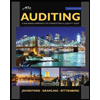
Identify the option that is not part of definition of internal control.
Answer to Problem 1QC
Option a.
Explanation of Solution
Internal control: Internal control is a process which ensures continuous reliability of accomplishment of a company’s objectives, related to operations, financial reporting, and in conformity with laws and regulations. The purposes of internal control and application of each purpose is explained as follows:
- Safeguard assets: The first purpose of internal control is to safe guard or protect assets like cash and inventory, from theft and robbery. An application of this purpose is to use physical controls like cash register and safes.
- Accuracy and reliability of accounting records: The second purpose of internal control is to enhance the reliability and accuracy, by decreasing the intentional and unintentional errors, and anomalies. An application of this purpose is to prepare bank reconciliation.
- Operational efficiency: The third purpose of internal control is to enhance the efficacy and efficiency of the business operations. An application of this purpose is to authorize responsibilities to the employees and make them accountable.
- Assurance of compliance of laws and regulations: The fourth purpose of internal control is to follow laws and regulations in compliance with the governing authorities. An application of this purpose is to document sales tax on cash tapes at the point of sale machines.
Separation of duties is not a part of internal control. But, it is an internal control procedure that is used in helping the management to find out the frauds that happen in the organization. Thus, option a. is not a part of definition of internal control and hence it is the correct answer.
Options (b), (c) and (d) form the part of definition of internal control and hence, these are incorrect answers.
Therefore, the correct answer is option a.
Want to see more full solutions like this?
Chapter 7 Solutions
Horngren's Financial & Managerial Accounting, The Financial Chapters Plus MyLab Accounting with Pearson eText -- Access Card Package (6th Edition)
- Need the WACC % WACC and Optimal Capital Structure F. Pierce Products Inc. is considering changing its capital structure. F. Pierce currently has no debt and no preferred stock, but it would like to add some debt to take advantage of the tax shield. Its investment banker has indicated that the pre-tax cost of debt under various possible capital structures would be as follows: Market Debt-to-Value Ratio (wd) Market Equity-to-Value Ratio (ws) Market Debt-toEquity Ratio (D/S) Before-Tax Cost ofDebt (rd) 0.0 1.0 0.00 6.0 % 0.10 0.90 0.1111 6.4 0.20 0.80 0.2500 7.0 0.30 0.70 0.4286 8.2 0.40 0.60 0.6667 10.0 F. Pierce uses the CAPM to estimate its cost of common equity, rs, and at the time of the analaysis the risk-free rate is 5%, the market risk premium is 7%, and the company's tax rate is 25%. F. Pierce estimates that its beta now (which is "unlevered" because it currently has no debt) is 1.4. Based on this information, what…arrow_forwardI need help finding the accurate solution to this financial accounting problem with valid procedures.arrow_forwardI am trying to find the accurate solution to this general accounting problem with the correct explanation.arrow_forward
- Union Audio Systems produces car sound systems. Estimated sales (in units) are 52,000 in July, 47,000 in August, and 43,500 in September. Each unit is priced at $85. Union wants to have 35% of the following month's sales in ending inventory. That requirement was met on July 1. Each sound system requires 5 speakers and 12 feet of wiring. Speakers cost $7 each, and wiring is $0.60 per foot. Union wants to have 30% of the following month's production needs in ending raw materials inventory. On July 1, Union had 35,000 speakers and 110,000 feet of wire in inventory. What is Union's expected sales revenue for August?arrow_forwardNot use ai solution please and accounting questionarrow_forwardI am trying to find the accurate solution to this general accounting problem with the correct explanation.arrow_forward
- Please provide the accurate answer to this financial accounting problem using appropriate methods.arrow_forwardI need guidance with this general accounting problem using the right accounting principles.arrow_forwardI am looking for the correct answer to this general accounting problem using valid accounting standards.arrow_forward
 Auditing: A Risk Based-Approach (MindTap Course L...AccountingISBN:9781337619455Author:Karla M Johnstone, Audrey A. Gramling, Larry E. RittenbergPublisher:Cengage Learning
Auditing: A Risk Based-Approach (MindTap Course L...AccountingISBN:9781337619455Author:Karla M Johnstone, Audrey A. Gramling, Larry E. RittenbergPublisher:Cengage Learning Auditing: A Risk Based-Approach to Conducting a Q...AccountingISBN:9781305080577Author:Karla M Johnstone, Audrey A. Gramling, Larry E. RittenbergPublisher:South-Western College PubPrinciples of Accounting Volume 2AccountingISBN:9781947172609Author:OpenStaxPublisher:OpenStax College
Auditing: A Risk Based-Approach to Conducting a Q...AccountingISBN:9781305080577Author:Karla M Johnstone, Audrey A. Gramling, Larry E. RittenbergPublisher:South-Western College PubPrinciples of Accounting Volume 2AccountingISBN:9781947172609Author:OpenStaxPublisher:OpenStax College- Principles of Accounting Volume 1AccountingISBN:9781947172685Author:OpenStaxPublisher:OpenStax College
 Cornerstones of Financial AccountingAccountingISBN:9781337690881Author:Jay Rich, Jeff JonesPublisher:Cengage Learning
Cornerstones of Financial AccountingAccountingISBN:9781337690881Author:Jay Rich, Jeff JonesPublisher:Cengage Learning Intermediate Financial Management (MindTap Course...FinanceISBN:9781337395083Author:Eugene F. Brigham, Phillip R. DavesPublisher:Cengage Learning
Intermediate Financial Management (MindTap Course...FinanceISBN:9781337395083Author:Eugene F. Brigham, Phillip R. DavesPublisher:Cengage Learning





